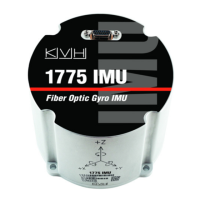This document contains proprietary information of KVH Industries, Inc. and neither this document nor said proprietary information shall be
published, reproduced, copied, disclosed, or used for any purpose without the express written permission of a duly authorized KVH
representative.
Table 11-1: TOV Timing Parameters
MSYNC,IMU: high time is 10% of the TOV period (for
example, at a default baud rate of 1,000 Hz, the T0 high
time will be 100 µs for internal clock mode)
MSYNC,EXT: high time is approximately the same as the
external MSYNC signal active time
MSYNC,IMU: Period is determined by the output data
rate (for example, at default data rate of 1,000 Hz, T2 =
1000 µs)
MSYNC,EXT: period reflects the external MSYNC signal
Duration of the serial
port output
Depends on output format and baud rate; approximately
equal to the number of characters output multiplied by
the number of bits per character (10) divided by the baud
rate (for example, Format A at default baud rate of
921600 Bd, T3 is approximately 390 µs)
Time between rising
edge of TOV-Out and
the end of data
transmission
<500 µs (at default baud rate of 921600 Bd)
Time between start of
TOV and the start of T2
11.3 TOV with Internal MSYNC Mode
When the IMU is providing its own data output requests based on its internal source’s
preconfigured rate, the unit outputs the differential TOV signal with a 10% duty cycle at the
same frequency as the data output (see the diagram in Figure 11-1 and the parameters in
Table 11-1).
11.4 TOV with External MSYNC Active
When the external Master Synchronization Input is configured, the IMU will simply buffer
(repeat) the MSYNC signal back out to the TOV signal. Therefore, the timing should closely
mirror the external MSYNC signal.

